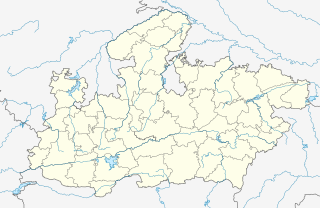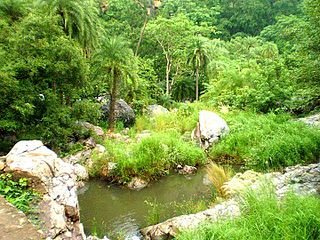 W
WThe Khathiar-Gir dry deciduous forests is a mostly arid ecoregion in northwestern India that stretches over 103,100 sq mi (267,000 km2) across Gujarat, Rajasthan and Madhya Pradesh. The dry deciduous forests in the region are dominated by teak, and thorny trees and scrub in drier areas.
 W
WThe Aravalli Range is a mountain range in Northwestern India, running approximately 692 km (430 mi) in a south-west direction, starting near Delhi, passing through southern Haryana and Rajasthan, and ending in Gujarat. The highest peak is Guru Shikhar at 1,722 metres (5,650 ft).
 W
WBalaram Ambaji Wildlife Sanctuary is located at Banaskantha, Gujarat, India. It covers 542 km2, and falls in the catchment area of Banas and Sabarmati rivers, and is a part of the Kathiawar-Gir dry deciduous forests' ecoregion. The sanctuary borders Rajasthan. The period from October to May is considered to be the best time to visit.
 W
WDhebar Lake is India's second-largest artificial lake, after Govind Ballabh Pant Sagar. It is located in the Udaipur District of Rajasthan State in western India. It has an area of 87 km2 (34 sq mi) when full, and was created in the 17th century, when Rana Jai Singh of Udaipur built a marble dam across the Gomati River. It is about 45.0 km (28.0 mi) from the district headquarters of Udaipur. When first built, it was the largest artificial lake in the world. The surrounding Jaisamand Wildlife Sanctuary around Dhebar Lake can be reached by the state highway to Banswara from Udaipur. It is about 27.0 km (16.8 mi) from Parsad. Jaisamand Wildlife Sanctuary protects about 162.0 square kilometres (16,200 ha), mostly teak forest, on the shores of Dhebar Lake. The lake has three islands measuring from 10 to 40 acres each. The Dhebar Lake Marble Dam is 300.0 m (984.3 ft) long and is a part of the "Heritage Monuments of India". The dam also has the Hawa Mahal Palace, winter Capital of the erstwhile Maharanas of Mewar. 1687 to 1691
 W
WGandhi Sagar Sanctuary is a wildlife sanctuary situated on the northern boundary of Mandsaur and Nimach districts in Madhya Pradesh, India. It is spread over an area of 368.62 km2 (142.32 sq mi) adjoining Rajasthan state in India. It was notified in 1974 and more area was added in 1983. The Chambal River passes through the sanctuary dividing it into two parts. The western part is in Nimach district and eastern part is in Mandsaur district. It is in the Khathiar-Gir dry deciduous forests ecoregion.
 W
WGir National Park and Wildlife Sanctuary, also known as Sasan Gir, is a forest and wildlife sanctuary near Talala Gir in Gujarat, India. It is located 43 km (27 mi) north-east of Somnath, 65 km (40 mi) south-east of Junagadh and 60 km (37 mi) south-west of Amreli. It was established in 1965, with a total area of 1,412 km2 (545 sq mi), of which 258 km2 (100 sq mi) is fully protected as national park and 1,153 km2 (445 sq mi) as wildlife sanctuary. It is part of the Khathiar-Gir dry deciduous forests ecoregion.
 W
WJambughoda is a Wildlife Sanctuary situated in Jambughoda Tehsil, in the South-Central part of Gujarat, and the Kathiawar-Gir dry deciduous forests' ecoregion in India. It is located 70 km from Vadodara and 20 km from prominent tourist places such as Pawagadh and Champaner.
 W
WKumbhalgarh Wildlife Sanctuary is located in the Rajsamand District of Rajasthan State in western India. It surrounds the Kumbhalgarh fortress and covers an area of 610.528 km2 (236 sq mi). The sanctuary extends across the Aravalli Range, covering parts of Rajsamand, Udaipur, and Pali districts, ranging from 500 to 1,300 metres in elevation. It is part of the Khathiar-Gir dry deciduous forests ecoregion.
 W
WKuno National Park is a protected area in Madhya Pradesh that received the status of national park in 2018. The protected area was established in 1981 as a wildlife sanctuary with an area of 344.686 km2 (133.084 sq mi) in the Sheopur and Morena districts. It was also known as Kuno-Palpur and Palpur-Kuno Wildlife Sanctuary. It is in the Khathiar-Gir dry deciduous forests ecoregion.
 W
WMadhav National Park is situated in Shivpuri District of Gwalior division in northwest Madhya Pradesh, India. Two national highways pass through the park, the Agra to Bombay former National Highway 3 and the Jhansi to Shivpuri National Highway 27.
 W
WMount Abu Wildlife Sanctuary is located in one of the oldest mountain ranges of India, the Aravalli range. It was declared a wildlife sanctuary in 1980.
 W
WNational Chambal Sanctuary, also called the National Chambal Gharial Wildlife Sanctuary, is a 5,400 km2 (2,100 sq mi) tri-state protected area in northern India for the protection of the Critically Endangered gharial, the red-crowned roof turtle and the Endangered Ganges river dolphin. Located on the Chambal River near the tripoint of Rajasthan, Madhya Pradesh and Uttar Pradesh, it was first declared in Madhya Pradesh in 1978, and now constitutes a long narrow eco-reserve co-administered by the three states. Within the sanctuary, the pristine Chambal River cuts through mazes of ravines and hills with many sandy beaches.
 W
WPolo forest, also known as Vijaynagar forest, is a dry mixed deciduous forest near Abhapur village in Vijaynagar Taluka, Sabarkantha district, Gujarat, India. It is located at the foothills of the Aravalli range and on the banks of perennial Harnav river, spread over the area of 400 square kilometres.
 W
WRamgarh Lake was an artificial lake situated near Jamwa Ramgarh in Rajasthan, India. The last time the lake received water was 1999 and it has been dry since 2000. It is situated 32 kilometres (20 mi) from Jaipur, and covers a maximum area of 15.5 square kilometres (6.0 sq mi). At one time the lake was the main source of water supply to Jaipur City. It was a popular picnic spot, particularly after the rainy season.
 W
WRanthambore National Park is a national park in Rajasthan, northern India, with an area of 1,334 km2 (515 sq mi). It is bounded to the north by the Banas River and to the south by the Chambal River. It is named after the historic Ranthambore Fort, which lies within the park.
 W
WSailana is a town and a nagar panchayat in Ratlam district in the Indian state of Madhya Pradesh. It is located in the Malwa region of Madhya Pradesh. Sailana is 25 km from Ratlam city and 50 km away from Banswara district of the neighboring state of Rajasthan.
 W
WSariska Tiger Reserve is a tiger reserve in Alwar district, Rajasthan, India. It stretches over an area of 881 km2 (340 sq mi) comprising scrub-thorn arid forests, dry deciduous forests, grasslands, and rocky hills. This area was a hunting preserve of the Alwar state and was declared a wildlife reserve in 1955. It was given the status of a tiger reserve making it a part of India's Project Tiger in 1978. The wildlife sanctuary was declared a national park in 1990, with a total area of about 273.8 km2 (105.7 sq mi). It is the first reserve in the world with successfully relocated tigers. It is an important biodiversity area in the Northern Aravalli leopard and wildlife corridor.
 W
WThe Sita Mata Wildlife Sanctuary is a wildlife sanctuary situated in Pratapgarh and Chittaurgarh districts of Rajasthan Rajasthan, India, declared as a protected forest area by the Government of Rajasthan Notification No. F 11 (9) Revenue/8/79, dated 2/11/1979. It is a dense forest, with an area of 422.95 square kilometers, which is about 40% of the total land area of the district. The land is undulating because of the confluence of three different formations — Malwa Plateau, the Vindhyachal Hills and Aravali mountain ranges.